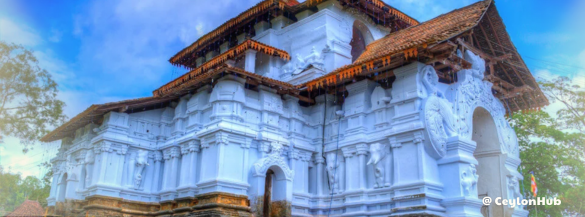Introduction
“While the Temple of the Tooth Relic steals the spotlight, Gadaladeniya whispers stories of a bygone era through its weathered stone walls.”
Nestled amid lush hills 15 km from Kandy, this 14th-century temple is a testament to Sri Lanka’s multicultural past. Designed by a South Indian architect but rooted in Sinhalese Buddhist traditions, Gadaladeniya is where art, faith, and mystery collide.
1. A Temple Born from Two Cultures
- History: Built in 1344 CE by King Buwanekabahu IV, designed by South Indian architect Ganesvarachari.
- Architectural Fusion:
- Dravidian Influence: Ornate vimana (tower) resembling South Indian temples.
- Sinhalese Touches: Stupa-like pinnacle and moonstone carvings.
- The Stone Boat Legend: Locals believe the temple was shaped like a boat to survive mythical floods.
2. What to See & Do
- Main Shrine: A towering gedige (stone structure) housing a Buddha statue under a cosmic Mandala painting.
- Guardian Deities: Unique carvings of Hindu gods (Vishnu, Saman, and Vibhishana) guarding the Buddhist shrine.
- Ancient Inscriptions: Look for 14th-century Brahmi scripts near the entrance.
Pro Tip: Visit at sunrise for golden light streaming through the temple’s arched windows.
3. Practical Tips for Visitors
- Location: 15 km from Kandy city (30-min drive; use the Pilimatalawa route).
- Entry Fee: $3 USD (free for locals).
- Guided Tours: Hire a guide (~₵1500 LKR) at the site to decode hidden symbols.
4. Hidden Spots Most Miss
- Moonstone Carvings: Intricate elephant-and-lotus motifs at the entrance—a signature of Kandyan artistry.
- Upper Terrace: Climb the narrow stairs for panoramic views of Sri Lanka’s central highlands.
5. 5 Essential FAQs
Q1: Why is Gadaladeniya called the “Stone Boat Temple”?
A: Its raised platform and elongated design mimic a boat, tied to legends of ancient floods.
Q2: Can I combine this with nearby attractions?
A: Yes! Pair it with Lankatilaka Temple (2 km away) or Embekka Devalaya (famous for wood carvings).
Q3: Is photography allowed inside?
A: Yes, but avoid using flash near ancient paintings.
Q4: Is the site wheelchair accessible?
A: Partially. The main courtyard is accessible, but the upper terrace requires climbing steep stairs.
Q5: What’s the best time to visit?
A: Mornings (8:00–10:00 AM) or late afternoons (3:00–5:00 PM) to avoid midday heat.
Local Insight
“Gadaladeniya isn’t just stones—it’s a bridge between two worlds. The Hindu gods here aren’t invaders; they’re protectors of the Buddha’s teachings.”
— Ms. Anoma, Kandy Heritage Guide
Emergency Contacts (General)
Police Emergency Hotline : 118 / 119
Ambulance / Fire & Rescue : 110
Tourist Police Hotline : 1912 (24/7 for tourist-related emergencies)
Leading Hospitals Nearby
National Hospital of Sri Lanka
Nawaloka Hospital Specialist Centre
Nearby Police Stations
Sri Lanka Police Station Directory
Fire and Rescue Services
Ambulance Services
Suwa Seriya Ambulance Service : 1990 (Free service)
St. John Ambulance : 077 -780- 5944
Embassies Nearby
Pharmacies
Pharmacy Near Me – Rainbow Pages
Union Chemists Pharmacy – Total Healthcare Support
Banks and ATMs
Bank of Ceylon – Our Touch Points
Commercial Bank – Locate Us
National Savings Bank ( NSB ) – Our Network
National Development Bank ( NDB ) – Locate NDB Branches & ATMs
Nations Trust Bank ( NTB ) – Branch Network
Peoples Bank – Nations Trust Bank ( NTB ) – Branch Network
Sampath Bank – Branch Locator
Seylan Bank – Branch Locator
Transportation Services
App-based services available for local transport.
Uber – Ride
PickMe – Book Your Taxi
Railway Station – Station Details
Bus Stand – Depots Contact Details
Safety Tips for Visiting Gadaladeniya Temple
- Dress Modestly: Ensure your shoulders and knees are covered. Avoid wearing shorts, sleeveless tops, or revealing clothing. Sarongs are available for rent or purchase at the entrance if needed.
- Footwear Handling: Remove shoes before entering the temple premises. Use the designated shoe storage area, which may require a small fee (~50–100 LKR).
- Photography Rules: Photography is generally allowed, but avoid using flash inside the shrine rooms. Always ask for permission before photographing people or sacred areas.
- Respect Local Customs: Avoid visiting during prayer times unless you are participating. Maintain silence and refrain from disruptive behavior.
- Crowd Management: Visit early morning or late afternoon to avoid peak crowds. Be cautious during festivals like Perahera, which attract large gatherings.
- Prohibited Items: Do not bring plastic bags, harmful materials, or bulky luggage. Offerings should be in eco-friendly containers.
- Children and Supervision: Ensure children are supervised at all times and informed about appropriate behavior in a religious setting.
- Emergency Preparedness: Stay hydrated and carry mosquito repellent. Use bottled water, as tap water near the temple is not drinkable.
- Accessibility: The temple is located on a rock plateau, so be prepared for steps and uneven ground. Visitors with mobility issues should plan accordingly.
- Local Guides: Consider hiring a local guide for a deeper understanding of the temple’s history and architecture. Guides are often available at the site.



